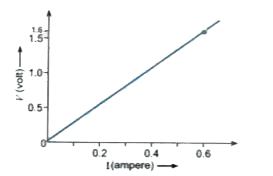State Ohm's law. Draw a labelled circuit diagram to verify this law in the laboratory. If you draw a graph between the potential difference and current flowing through a metallic conductor, what kind of curve will you get? Explain how would you use this graph to determine the resistance of the conductor.
Ohm's law states that the electric current, through a conductor, is directly proportional to the potential difference across its two ends when, other physical condition like temperature, etc., remain constant.
V∝I
orVI=Constant=R
orV=IR
Thus, the ratio V : I is a constant. This constant is called the resistance (R) of the conductor.
Circuit diagram for Ohm's law:

Explanation. If a graph is drawn between the potential difference (V) and current (I), the graph is found to be a straight line passing through the origin. This shows current is directly proportional to the potential difference. Thus the ratio VI remains constant. This constant is called the resistance of the conductor. The gradient of the straight ling graph is related to the resistance (R) of the conductor.
Topper's Solved these Questions
Similar Questions
The rate of Joule heat is given by P=V×I where V is the potential difference across the ends of a conductor and I is the current flowing through it. Does this relation hold for a condutor that does not obey Ohm's law?
View SolutionWhat would be the resistance of a conductor if the current flow through it is 0.35 A when the potential difference across is 1.4 V?
View Solution
Knowledge Check
- Question 1 - Select One
Which law states the relationship between the potential difference across a conductor and the current flowing through it ?
ANewton's lawBFaraday's lawCOhm's lawDJoules law - Question 2 - Select One
If V is the potential difference between the ends of conductor and l is the current through it, then ohm's law states that
AV∝lBV∝1lCV∝l2DV∝l0 - Question 3 - Select One
Imagine a conductor through which a current I is flowing and let V be the potential difference between the ends of the conductor. Then, Ohm’s law states that
AV∞lBV = RICV = 2 RIDBoth (1) and (2)
(a) Name an instrument that measures electric current in a circuit. Define the unit of electric current.
(b) What do the following symbols represent in a circuit diagram?

(c) An electric circuit consisting of a 0.5 m long nichrome wire XY, an ammeter, a voltmeter, four cells of 1.5 V each and a plug key was set up.
(i) Draw the electric circuit diagram to study the relation between the potential difference maintained between the points 'X' and 'Y' and the electric current flowing through XY.
(ii) Following graph was plotted between Vand I values using above circuit:

What would be the values of ratios when the potential difference is 0.8 V, 1.2 V and 1.6 respectively? What conclusion do you draw from these values?View SolutionExplain the determination of unknown resistance using meter bridge.
View Solution(a) The components of an electric circuit are 0.5 m long nichrome wire XY, an ammeter, a voltmeter, four cells of 1.5 V each, rheostat and a plug key. Draw a circuit diagram to study the relation between potential difference across the terminals X and Y of the wire and current flowing through it.
(b) State the law that relates potential difference across a conductor with the current flowing through it.View SolutionA resistor of 4 ohm resistance and an electric lamp of 20 ohm resistance are connected in series across a 6 volt battery. Draw a lebelled circuit diagram by using the symbols for ohm and volt. Calculate:
(a) total resistance of the circuit.
(b) current flowing through the circuit.
(c) potential difference across the resistor.
(d) potential difference across the electric lamp.View Solution(a) What is the ratio of potential difference and current known as?
(b) The values of potential difference V applied across a resistor and the corresponding values of current I flowing in the resistor are given below:
Potential differenceV(in volts):2.55.010.015.020.025.0Current,I(in amperes):0.10.20.40.60.81.0
Plot a graph between V and I, and calculate the resistance of the resistor.
(c) Name the law which is illustrated by the above V-I graph.
(d) Write down the formula which states the relations between potential difference, current and resistance.
(d) The potential difference between the terminals of an electric iron is 240V and the current is 5.0A. What is the resistance of the electric iron?View Solution
